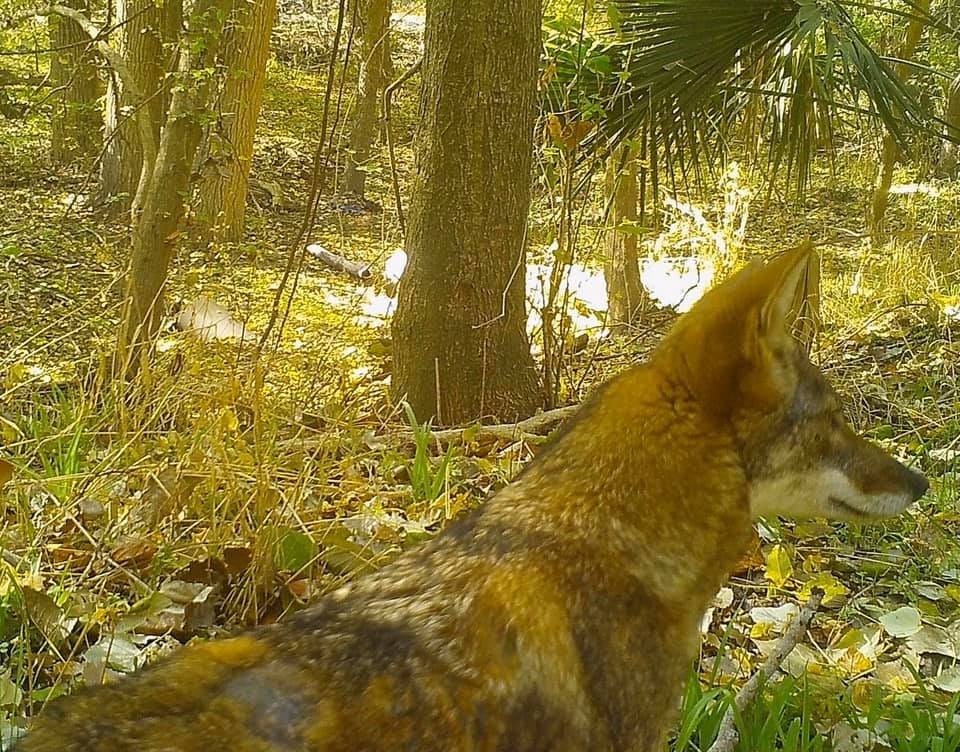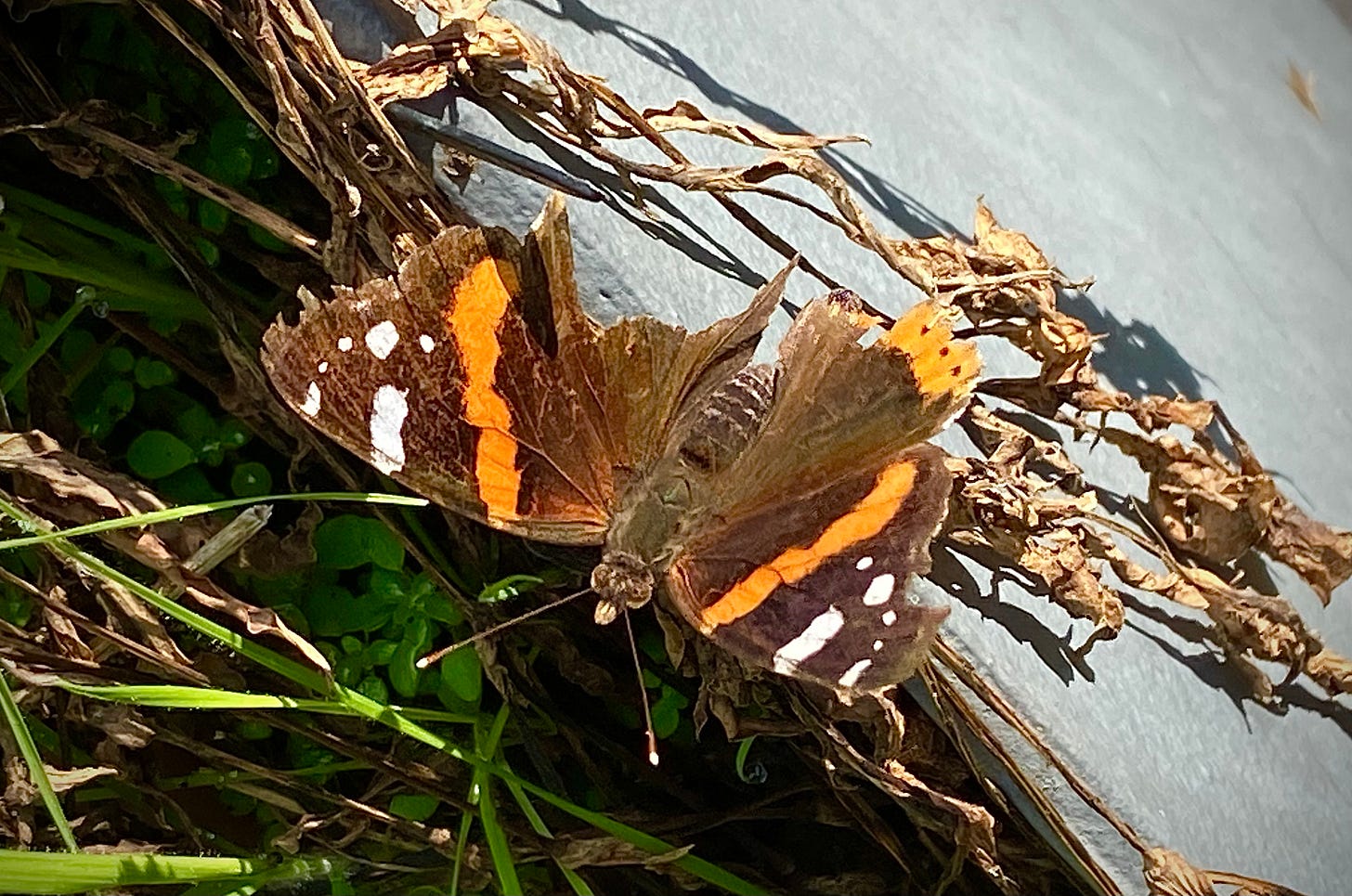Fungus garden Noël
Tuesday at sunup the black mouth cur and I walked down into the thick fog along the river as a cool night tried to dial up into a warm day. Those misty winter mornings are the most beautiful here, the way they obfuscate the ugliness we make and lend every vista a blurry romance. You couldn’t see the office towers that normally appear over the western treeline, and you could barely even see the bits of soapy discharge that drift in the slow currents flowing from the dam. The herons and ducks were out there in the shallows, enjoying what bounty the river still provides them, and maybe enjoying the way the fog also seemed to muffle the machine sounds of the human city.
Sunday afternoon we went to a “meet the baby” reception of some friends who had come through a very difficult delivery in the summer, following the sort of effort at conception that only modern medical science can enable. The event was at the penthouse common area of one of the tallest condo towers downtown, fifty-five floors up. To distract our daughter from the scary Santa who greeted us as we stepped off the elevator, I took her to the windows to take in the insane view of the city, on what was a clear sunny day. When we got around to the view to the east, we looked to see if we could see our house. Of course we couldn’t—our buried green roof domicile is barely registrable as a building even when you’re standing in front of it. But you could see the zone where it is, and what was remarkable was how really tiny the sliver of urban woods around us is, within the scale of the metropolis. The river below the dam was almost invisible, an interstitial wilderness that the city quite literally cannot see.
I used to have a view like that when I worked at a downtown law firm, and as my daughter and I tried to identify familiar landmarks from that lofty vantage, I took note of what had changed over the past decade and a half, like the old Latino neighborhoods just east of downtown that have been completely redeveloped into playgrounds for young professionals. And then I noticed, almost at the eastern horizon, a new structure so huge that, even though it was the farthest thing in the frame, it was bigger than even the span of the bridge or the sprawl of the airport. The new Tesla factory, recently announced as the company’s relocated global headquarters.
The leviathan scale of the facility, and the speed with which it has arisen from the site of an old gravel pit—eighteenth months from buying the land to rolling the first car off the line—drove home the recognition of just how much capital that operation embodies, and the kind of techno-libertarian tomorrow it represents, as the social, economic and environmental landscape around it gets rapidly reshaped by the personality of one eccentric 21st century baron. Watching how much more powerful our colorful new oligarch is than any of our county and city officials, I found myself thinking that those East Austin Maoists who tag the abandoned buildings down the street with calls to boycott the sham elections and join the revolution have a point.
But instead of preparing the fifth column, I spent a chunk of my week along with some nonprofit colleagues engaging with Tesla representatives about river conservation. In their defense, they seem to be doing a lot of the right things, or at least talking the talk. But you can tell the company has come to this place because they know no one can really impede their freedom to do what they want to do, and any bones they throw to ecological restoration are princely gratuities you are not really invited to negotiate. It will be interesting to see if grassroots Austin can organize quickly enough to provide any check on the power of these new forces moving into our community.
Back here where the older factories still operate at what used to be the edge of town, you can see the signs of animal action as winter sets in. The flora seem to forecast a lush green spring. The goldenrod has already sprouted in our wet sandy side yard, even though it won’t bloom for ten months. The warm air makes you wonder if real winter will ever arrive, and then the paper tells you about the disturbing changes in the Antarctic sea current that is the main cooling force of the planet, changes the climate crisis forecasts didn’t really factor into they model. A reminder that the leapfrogging to emissions-free vehicles being enabled downriver has its virtues.
We’ve been hearing the coyotes at night, after a quiet summer, and I notice our dog, who normally spends most of her time watching for human weirdos at our front gate, has been watching the woods after dark. I have not seen one yet this season, but this week’s memory bot served up this patchwork beauty at our back fence two years ago Thursday.
I keep thinking the last butterflies have come and gone, and then more stragglers show up. I spotted this red admiral by our front steps the other day, its wings jagged and torn but still able to fly with remarkable strength. Chances are it plans to spend the winter here after a long migration, a good bit further north than Vanessa atalanta normally stops. The species, originally called the red admirable by the English, was Nabokov’s favorite. The Russians called it the butterfly of doom.
In the thin stretch of weedy dirt that runs between the sidewalk and curb of our long block, little divots appear every morning where armadillos have been digging up grubs while we sleep. I had noticed a fresh armadillo den outside my trailer earlier in the fall, and I wonder if it’s just that one lone bull who has turned the right of way across from the warehouses into his unlikely smorgasbord.
Friday night we ate dinner at the diner down the street, and as we walked back we found a much more communitarian species at work in the same zone—a huge army of leaf cutter ants using the curb as their superhighway, each one carrying a fresh-cut green fragment.
The leaves are not building material, but the medium from which the ants are growing a huge subterranean fungus garden, ruled over by a committee of underground queens. The main gate to their secret city is here, next to our neighbors’ driveway. With enough food, the colony could grow to as many as two million ants, in tunnels that sprawl across fifty feet or more, and feeder tunnels that reach ten times as far.
In the spring, the virgin queen will tuck a little wad of that myrmecological mother in a pocket of her mouth, emerge from her hole between the sidewalk and the curb, and take to the air for her nuptial flight under the new moon, chased by a cloud of suitors who will die after they complete their mission of insemination. The first babies will eat the food the queen carries, and then their mama will eat most of them. The later broods will be bigger, as the colony grows with its food sources. It’s not unreasonable to think the ants will outlast us, though you can bet they will continue to take architectural advantage of the concrete forms we leave behind.
Further reading
For more on Nabokov and the red admiral, you can go read Pale Fire, or start smaller with this post from Florida nature blog Serenity Spell.
For more on the weird world of the Texas leaf-cutter ant, this post from Texas A&M Extension Urban Entomologist Michael Merchant is pretty great.
This Saturday New York Times report on the disturbing changes in the oceans around Antarctica, where deep stores of carbon dioxide in centuries’ old water are beginning to be released into the atmosphere, and warming currents are melting the ice shelves. It’s a weirdly beautiful story even as it delivers such foreboding news, and though I read it in the print edition the graphics in the digital edition are so good they almost make you believe in the positive benefits of the World Wide Web again.
For those who have been interested in the bits I have shared here about the natural history of the bois d’arc tree, also known as the Osage orange, Texas Monthly has a great piece about that tree from Allegra Hobbs up this week.
And farther west, Technology Review has an exceptional story from Mark Arax up this week about we drained California dry. The piece does a great job of weaving together economic history and natural history to tell a powerful story about where things are and where they are going.
Lastly, if you’re looking for a worthy urban ecology cause for your year-end donations, please consider the Colorado River Conservancy, a project I have helped launch this year with the amazing team at Austin’s PODER. And if you prefer the arts, here’s a link to the Alex Brown Foundation, a nonprofit we started this year to operate an artist’s residency in the studio of my late brother Alex Brown.
Field Notes will be off next weekend for the holiday. Merry Christmas to those of you who observe it, and I look forward to continuing this newsletter in the new year. Thanks to all of you who have replied to these posts, shared them them, or otherwise spread the word. I’m trying to develop a longer form work that uses this material, and the input and reactions many of you have provided have been tremendously helpful as I work on that.












It's disheartening to imagine that these big corporations are moving here because it's either been implied or (I suspect) spelled out to them by the powers that be that there will be zero ramifications for whatever environmental damage they may cause. No doubt writing like Field Notes will become increasingly important as the transformation of Austin and the Hill Country continues to gather pace.
Thanks for a year of great essays - I've really enjoyed them.